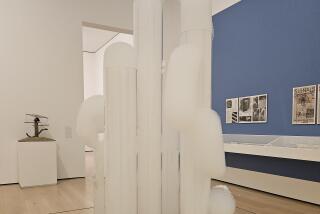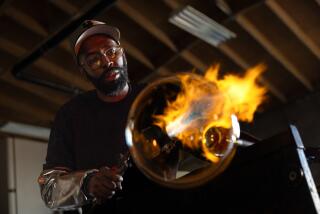Raw Talent
On portions of a newly felled oak tree, make a series of long, curving cuts, following the grain of the wood. Let the wood dry out. Observe how the cuts lose their knife-edge cleanness and develop irregular, feathery contours. Call the piece “Wings.”
*
British sculptor David Nash is internationally known for his subtle collaborations with nature. Living in the rugged countryside of North Wales, he makes decisions about the shapes of his sculptures based on the growth patterns of the trees and on his contemporary taste for minimal form. But the wood always has the last word.
Nash’s work, last seen locally in 1987 in “A Quiet Revolution: British Sculpture Since 1965” at the Newport Harbor Art Museum, is the subject of a one-man show of recent sculpture and drawing opening tonight at L.A. Louver gallery in Venice. Saturday morning, Nash will give a talk at the Orange County Museum of Art in Newport Beach.
On a recent evening in Blaenau Ffestiniog, he picked up the phone and looked out the window at a glittering black mountain of slate--discards from a quarry just 300 yards from his home.
“It’s a bit like a tidal wave,” he said, searching for a simile that might register in Southern California. “Every one of the rocks, some weighing several tons, were manhandled to where they are.”
No stranger to moving big chunks of nature around, Nash has made pieces meant to live outdoors. One is a wooden boulder that has been gradually moving down a stream in North Wales since 1978. Another is a ring of ash trees he has been grafting and pruning for 20 years; by the millennium, the limbs will form a domed shelter.
In recent years, Nash has made pieces in other countries, including the U.S. (using redwood in California, red oak and maple in St. Louis) and Japan, where his Zen-like attitude toward the nature aesthetic is especially appreciated. Each outdoor piece is a response to the specific atmosphere and type of wood at the site.
“The facts of the situation are where I start from,” he said. “One needs to see the tree in the wind and observe how it grows in its environment. [The approach] is not sentimental or idiosyncratic. I don’t see that there’s anything clever. It’s always very basic.”
Nash said he needs to psych himself into a clear, receptive frame of mind so can solve problems and see possibilities in a raw piece of wood.
“The mood builds up,” he said, as part of the process of assessing a given situation. “Seeing the tree that’s fallen over, [I think], ‘How are we going to move this? What can I do with this shape?’ And [I consider] its location: It might be precariously balanced on a hillside.”
Nash’s breakthrough came in 1970, when he revisited a piece he had temporarily abandoned: a group of wood balls hewn from a freshly felled ash tree. The warmth of the studio had caused the wood to crack into grinning “mouths,” as they seemed to him at the time, as if mocking his efforts.
Nash took this lesson from nature to heart. Subsequent pieces--cubes, canoe-shaped “vessels,” ladder forms--were allowed to warp and crack as they pleased.
“When I work with a natural material, there’s an intelligence there,” he said. “There’s more wisdom there than there is in me. That’s why I chose wood. I’m led to those forms [I use] by the wood itself.”
Nash replants trees to replace the ones he uses--which generally are cut for other purposes, such as boat-building. (He works with the leftover “off-cuts.”) Living in a country with thousands of years of agricultural history, however, Nash does not view nature as a pristine wilderness. He decries as “incredibly naive and facile” the attitudes of some preservationists.
*
People living in cities, he said, “tend to be extremely sanctimonious about nature because they have little conscious contact with it. . . . We all enjoy our wood doors and wood floors. It is a renewable source, and if you harvest the forest the right way, you will have a healthy forest.”
Some of Nash’s earlier pieces have a humorous quality somewhat reminiscent of Texas artist James Surls.
“When I was a young artist, minimal art was doing the necessary cleanup job, cleaning up a lot of sentimentality,” Nash said. “I subscribed to the philosophy but not to the objects, which I found extremely cold. [I had a need] to engage with the presence of a human being.”
Now in his early 50s, Nash coaxes an elemental grace and strength from abstract shapes. “The larger an object,” he said, “the simpler it needs to be.”
The largest of his recent sculptures are faceted columns, block forms and tall pieces of weathered Japanese birch with part of their surfaces cut away to mark the places where sunlight fell as they rested on a snowbank in Hokkaido.
By bringing the sculptures indoors, he said, “I bring the outside--the wind and the rain and the sun--with them.”
One recent group of pieces, the “bakes,” are small, plump pieces of oak and redwood, patterned with decorative cuts that open up as the wood ages.
Nash once stepped into a bakery in Bruges, Belgium, just when the baker was putting out the day’s bread. The sculptor asked about the cuts on top of the loaves, wondering whether the baker had made up the patterns.
Oh no, the baker replied. He was simply following tradition, using cuts that allowed the bread to expand as evenly as possible. Sure enough, when Nash tried different patterns of cuts on his wood pieces, the results were not satisfactory.
“It was trial and error, and they found the best way,” Nash said, clearly delighted to hear that the dough had spoken, and some long-ago baker had listened.
* Artist David Nash speaks at 11 a.m. Saturday at the Orange County Museum of Art, 850 San Clemente Drive, Newport Beach. $10; $8 for students and seniors. Reservations: (949) 759-1122, Ext. 204.
More to Read
The biggest entertainment stories
Get our big stories about Hollywood, film, television, music, arts, culture and more right in your inbox as soon as they publish.
You may occasionally receive promotional content from the Los Angeles Times.










